Paper Menu >>
Journal Menu >>
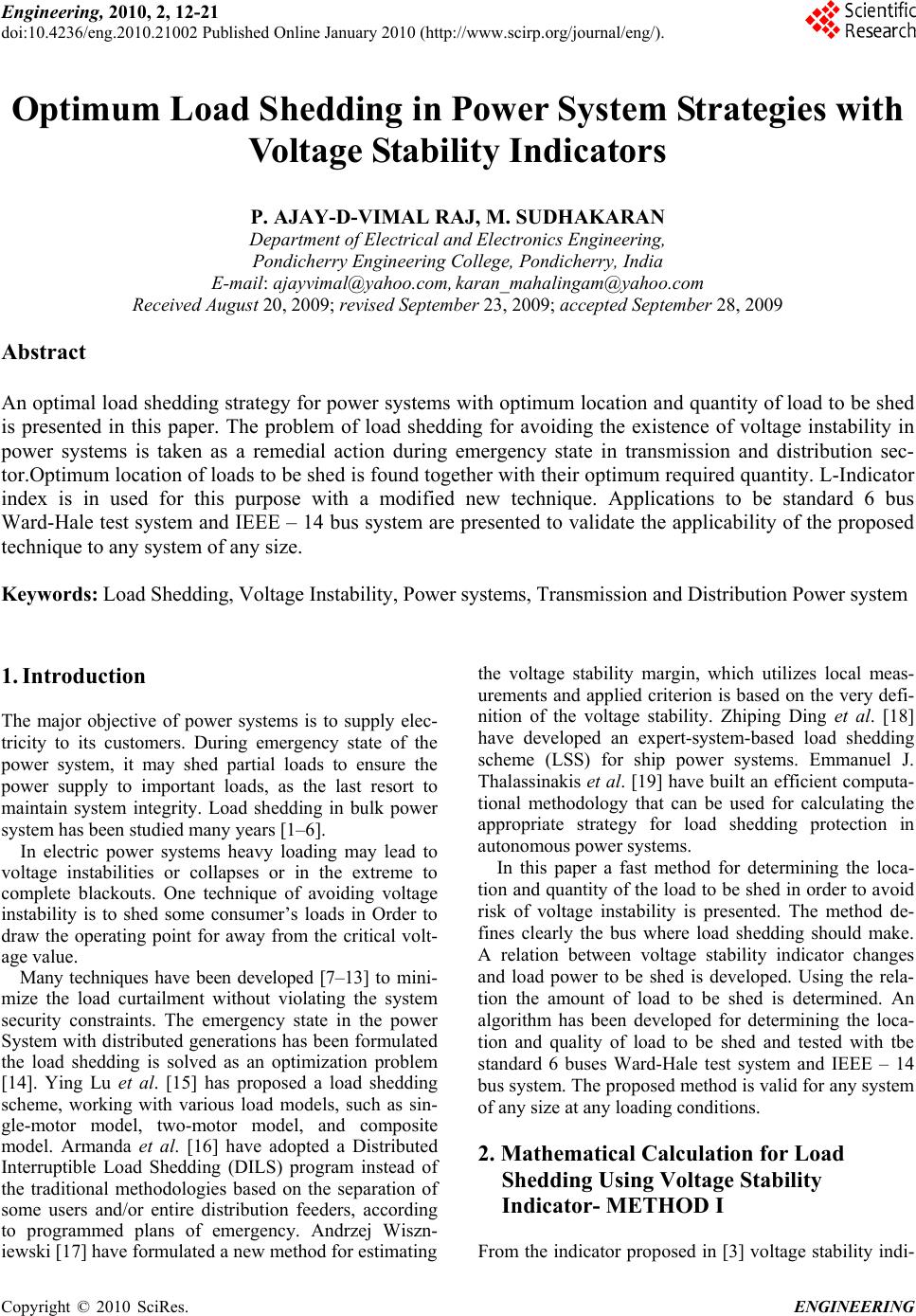 Engineering, 2010, 2, 12-21 doi:10.4236/eng.2010.21002 Published Online January 2010 (http://www.scirp.org/journal/eng/). Copyright © 2010 SciRes. ENGINEERING Optimum Load Shedding in Power System Strategies with Voltage Stability Indicators P. AJAY-D-VIMAL RAJ, M. SUDHAKARAN Department of Electrical and Electronics Engineering, Pondicherry Engineering College, Pondicherry, India E-mail: ajayvimal@yahoo.com, karan_mahalingam@yahoo.com Received August 20, 2009; revised September 23, 2009; accepted September 28, 2009 Abstract An optimal load shedding strategy for power systems with optimum location and quantity of load to be shed is presented in this paper. The problem of load shedding for avoiding the existence of voltage instability in power systems is taken as a remedial action during emergency state in transmission and distribution sec- tor.Optimum location of loads to be shed is found together with their optimum required quantity. L-Indicator index is in used for this purpose with a modified new technique. Applications to be standard 6 bus Ward-Hale test system and IEEE – 14 bus system are presented to validate the applicability of the proposed technique to any system of any size. Keywords: Load Shedding, Voltage Instability, Power systems, Transmission and Distribution Power system 1. Introduction The major objective of power systems is to supply elec- tricity to its customers. During emergency state of the power system, it may shed partial loads to ensure the power supply to important loads, as the last resort to maintain system integrity. Load shedding in bulk power system has been studied many years [1–6]. In electric power systems heavy loading may lead to voltage instabilities or collapses or in the extreme to complete blackouts. One technique of avoiding voltage instability is to shed some consumer’s loads in Order to draw the operating point for away from the critical volt- age value. Many techniques have been developed [7–13] to mini- mize the load curtailment without violating the system security constraints. The emergency state in the power System with distributed generations has been formulated the load shedding is solved as an optimization problem [14]. Ying Lu et al. [15] has proposed a load shedding scheme, working with various load models, such as sin- gle-motor model, two-motor model, and composite model. Armanda et al. [16] have adopted a Distributed Interruptible Load Shedding (DILS) program instead of the traditional methodologies based on the separation of some users and/or entire distribution feeders, according to programmed plans of emergency. Andrzej Wiszn- iewski [17] have formulated a new method for estimating the voltage stability margin, which utilizes local meas- urements and applied criterion is based on the very defi- nition of the voltage stability. Zhiping Ding et al. [18] have developed an expert-system-based load shedding scheme (LSS) for ship power systems. Emmanuel J. Thalassinakis et al. [19] have built an efficient computa- tional methodology that can be used for calculating the appropriate strategy for load shedding protection in autonomous power systems. In this paper a fast method for determining the loca- tion and quantity of the load to be shed in order to avoid risk of voltage instability is presented. The method de- fines clearly the bus where load shedding should make. A relation between voltage stability indicator changes and load power to be shed is developed. Using the rela- tion the amount of load to be shed is determined. An algorithm has been developed for determining the loca- tion and quality of load to be shed and tested with tbe standard 6 buses Ward-Hale test system and IEEE – 14 bus system. The proposed method is valid for any system of any size at any loading conditions. 2. Mathematical Calculation for Load Shedding Using Voltage Stability Indicator- METHOD I From the indicator proposed in [3] voltage stability indi-  P. AJAY-D-VIMAL RAJ ET AL. 13 cator at bus j can determine by j αGi iji jV VC 1 B (1) αLj where : Set of load buses. L α : Set of generator buses. G α : Voltage of generator bus i. i V : Voltage of load bus j. j V : Elements of matrix C determined by ji C C=- (2) -1 LL BLG B -1 LL Bis the imaginary part of the matrix 1 LL Y LG B is the imaginary part of the matrix LG Y -1 LL Band are susceptance matrices. LG B LL Yand are submatrices for the Y-Bus matrix. LG Y The indicator at bus j, determined by equation (1) can be separated into real and imaginary parts : RI jj B,B αG ji i i =1 j j CV B= 1- V i j (3) αG ji i RI i =1 jj j CVδi-δj B+jB= 1- V (4) j αG 1i iji R jV δjδicos VC 1B (5) αG ji i I i=1 j j CVsinδi-δj B= - V (6) δi,δ: voltage angles at buses i and j j i V,j V :voltage magnitudes at buses i and j The voltage stability indicator at each bus is a function of voltage angle and magnitude. The real imaginary part of indicator can be expressed as: I 1 R 2 B=F δ,V B=F δ,V (7) The partial derivative of Equations (5) and (6) with respect to voltage angle and magnitude changes can be determined as: II I RRR BB δVΔδ Δδ ΔBT ΔVΔV ΔBBB δV (8) Matrix [T] is sensitivity matrix between indicator changes and voltage angle and magnitude changes Coefficient of matrix [T] can be determined as cos Iji i J j CVi j B iV ,G iis (9) (S indicates the swing bus) ji i I jR iαG j j CVcosδi-δj B=- B-1 δjV f (10) R jjii j BCVsin(δi-δj) δiV (11) ji i R jI iαG j j CVsin(δi-δj) BB δjV (12) ji i II jj iαG 2 jj j CVsin(δi-δj) BB - VV V (13) ji i RR jj iαG 2 jj j CVcosδi-δj BB = VV V -1 - (14) From conventional Newton-Raphson load flow we obtain a linear relation between changes in voltage phases/magnitudes and active/reactive power injections as: -1 Δδ ΔP =j ΔVΔQ (15) Sub (15) in (8) we get a relationship between real and imaginary part indicators and injected power as: I-1 R ΔBΔP =T jΔQ ΔB (16) A relationship between changes in indicators at load bus j and power injections at all load buses can be ob- tained: I j11j12 j ΔB=S ΔP+S ΔQ (17) R j21j22 ΔB=SΔP+S ΔQj (18) Copyright © 2010 SciRes. ENGINEERING 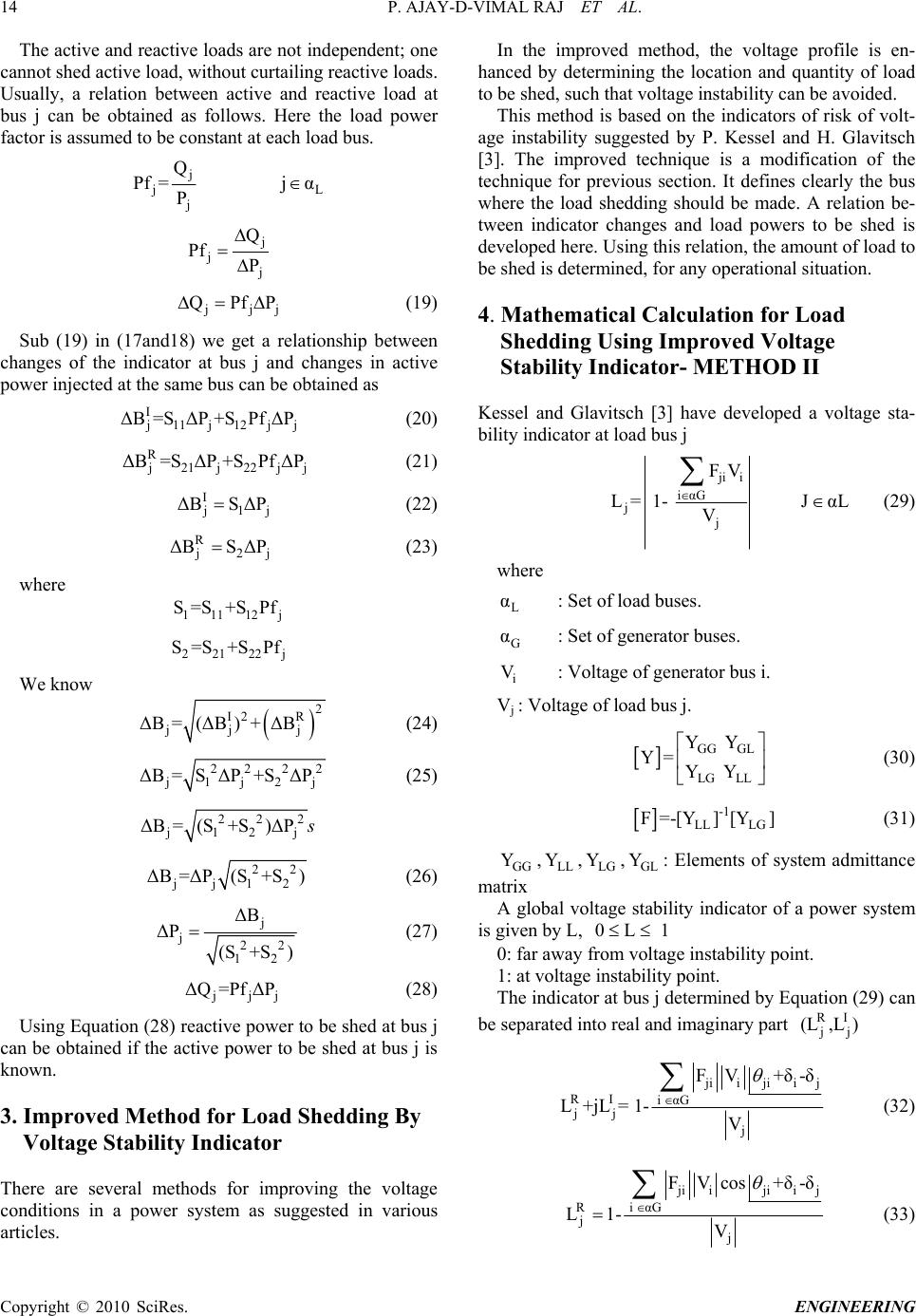 14 P. AJAY-D-VIMAL RAJ ET AL. The active and reactive loads are not independent; one cannot shed active load, without curtailing reactive loads. Usually, a relation between active and reactive load at bus j can be obtained as follows. Here the load power factor is assumed to be constant at each load bus. j j j Q Pf= P L jα j j j Q Pf P jj QPfP j j j j (19) Sub (19) in (17and18) we get a relationship between changes of the indicator at bus j and changes in active power injected at the same bus can be obtained as I j11j12j j ΔB=S ΔP+S PfΔP (20) R j21j22j ΔB=S ΔP+S PfΔP (21) I j1 ΔBSΔP (22) R j2 ΔBSΔP (23) where 11112j S=S+SPf 22122 S=S +S Pf j We know 2 I2 R jj j ΔB= (ΔB) + ΔB (24) 22 22 j1j2j ΔB= S ΔP+SΔP (25) 22 2 j12j ΔB= (S+S)ΔP s 22 jj12 ΔB=ΔP(S+S) (26) j j22 12 ΔB ΔP (S +S) (27) jj ΔQ=PfΔPj (28) Using Equation (28) reactive power to be shed at bus j can be obtained if the active power to be shed at bus j is known. 3. Improved Method for Load Shedding By Voltage Stability Indicator There are several methods for improving the voltage conditions in a power system as suggested in various articles. In the improved method, the voltage profile is en- hanced by determining the location and quantity of load to be shed, such that voltage instability can be avoided. This method is based on the indicators of risk of volt- age instability suggested by P. Kessel and H. Glavitsch [3]. The improved technique is a modification of the technique for previous section. It defines clearly the bus where the load shedding should be made. A relation be- tween indicator changes and load powers to be shed is developed here. Using this relation, the amount of load to be shed is determined, for any operational situation. 4. Mathematical Calculation for Load Shedding Using Improved Voltage Stability Indicator- METHOD II Kessel and Glavitsch [3] have developed a voltage sta- bility indicator at load bus j ji i iαG j j FV L= 1- V (29) JαL where L α : Set of load buses. G α : Set of generator buses. i V : Voltage of generator bus i. Vj : Voltage of load bus j. GG GL LG LL Y Y Y= Y Y (30) -1 LL LG F=-[Y] [Y] (31) GG Y, ,,: Elements of system admittance matrix LL YLG YGL Y A global voltage stability indicator of a power system is given by L, 0L 1 0: far away from voltage instability point. 1: at voltage instability point. The indicator at bus j determined by Equation (29) can be separated into real and imaginary part RI jj (L,L ) jiijiij RI i αG jj j FV +δ-δ L+jL= 1- V (32) jiijii j R i αG j j FVcos +δ-δ L1- V (33) Copyright © 2010 SciRes. ENGINEERING 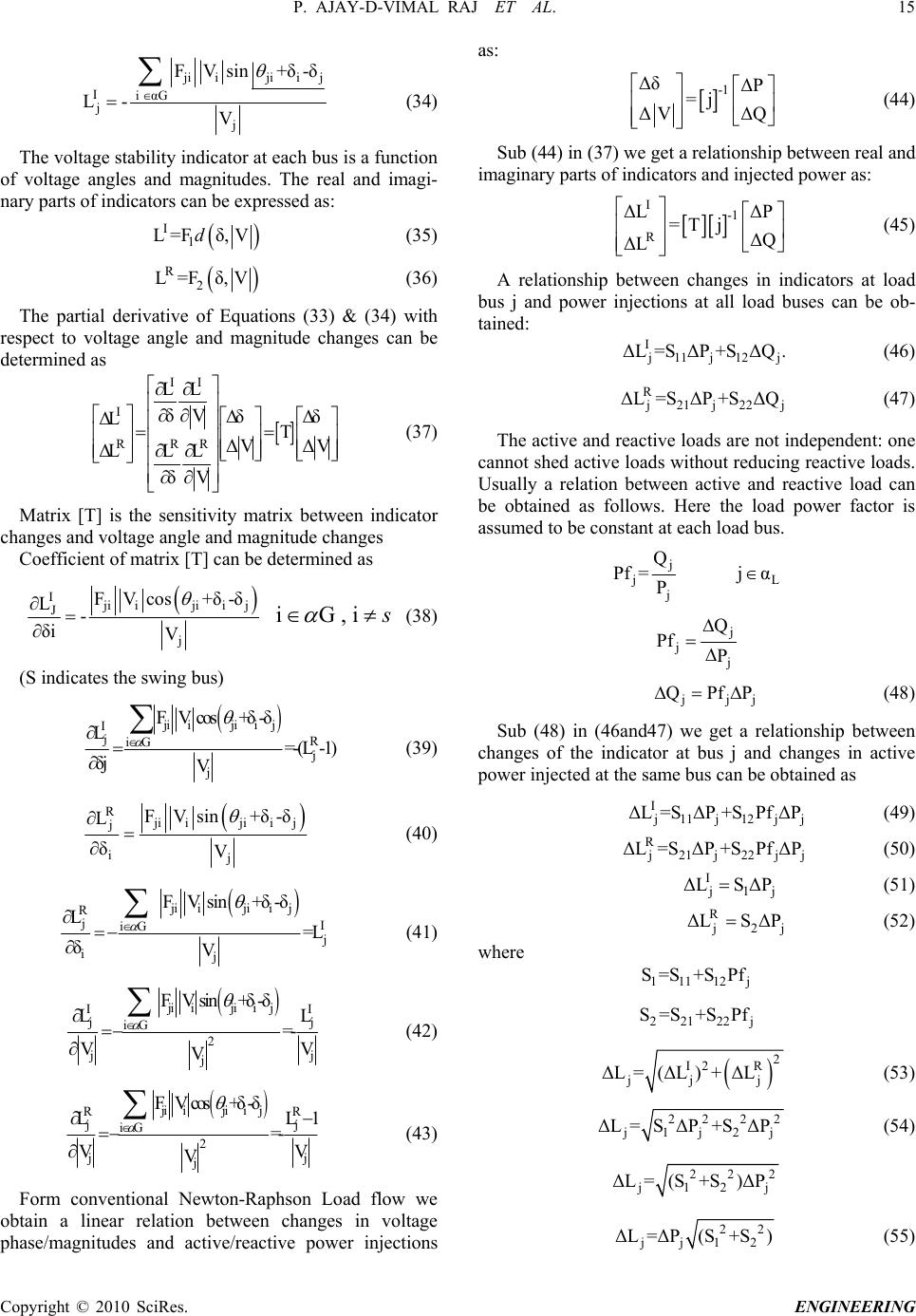 P. AJAY-D-VIMAL RAJ ET AL. 15 jiijii j I i αG j j FVsin +δ-δ L- V (34) The voltage stability indicator at each bus is a function of voltage angles and magnitudes. The real and imagi- nary parts of indicators can be expressed as: I 1 L=F δ,Vd (35) R 2 L=Fδ,V (36) The partial derivative of Equations (33) & (34) with respect to voltage angle and magnitude changes can be determined as II I RRR LL δVΔδ Δδ ΔLT ΔVΔV ΔLLL δV (37) Matrix [T] is the sensitivity matrix between indicator changes and voltage angle and magnitude changes Coefficient of matrix [T] can be determined as Ijiijiij J j FVcos +δ-δ L- δiV iG , is (38) (S indicates the swing bus) jiijii j I jR iG j j FVcos +δ-δ L=-(L -1) δjV (39) Rjiijii j j ij FVsin +δ-δ L δV (40) jiijii j R jI iG j ij FVsin+δ-δ L=L δV (41) jiijiij II jj iG 2 jj j FVsin +δ-δ LL =- VV V (42) jiijii j RR jj iG 2 jj j FVcos +δ-δ LL =- VV V 1 (43) Form conventional Newton-Raphson Load flow we obtain a linear relation between changes in voltage phase/magnitudes and active/reactive power injections as: -1 Δδ ΔP =j ΔVΔQ (44) Sub (44) in (37) we get a relationship between real and imaginary parts of indicators and injected power as: I-1 R ΔLΔP =T jΔQ ΔL (45) A relationship between changes in indicators at load bus j and power injections at all load buses can be ob- tained: I j11j12 j ΔL=S ΔP+SΔQ. (46) R j21j22 ΔL=S ΔP+S ΔQj (47) The active and reactive loads are not independent: one cannot shed active loads without reducing reactive loads. Usually a relation between active and reactive load can be obtained as follows. Here the load power factor is assumed to be constant at each load bus. j j j Q Pf= P L jα j j j Q Pf P jj QPfP j (48) Sub (48) in (46and47) we get a relationship between changes of the indicator at bus j and changes in active power injected at the same bus can be obtained as I j11 j12jj ΔL=S ΔP+S PfΔP (49) R j21j22j ΔL=S ΔP+S PfΔPj (50) I j1 ΔLSΔPj j (51) R j2 ΔLSΔP (52) where 11112j S=S+SPf 22122 S=S +S Pf j 2 I2 R jj j ΔL= (ΔL) + ΔL (53) 22 22 j1j2j ΔL=S ΔP+SΔP (54) 22 2 j12j ΔL= (S +S)ΔP 22 jj12 ΔL=ΔP(S+S) (55) Copyright © 2010 SciRes. ENGINEERING 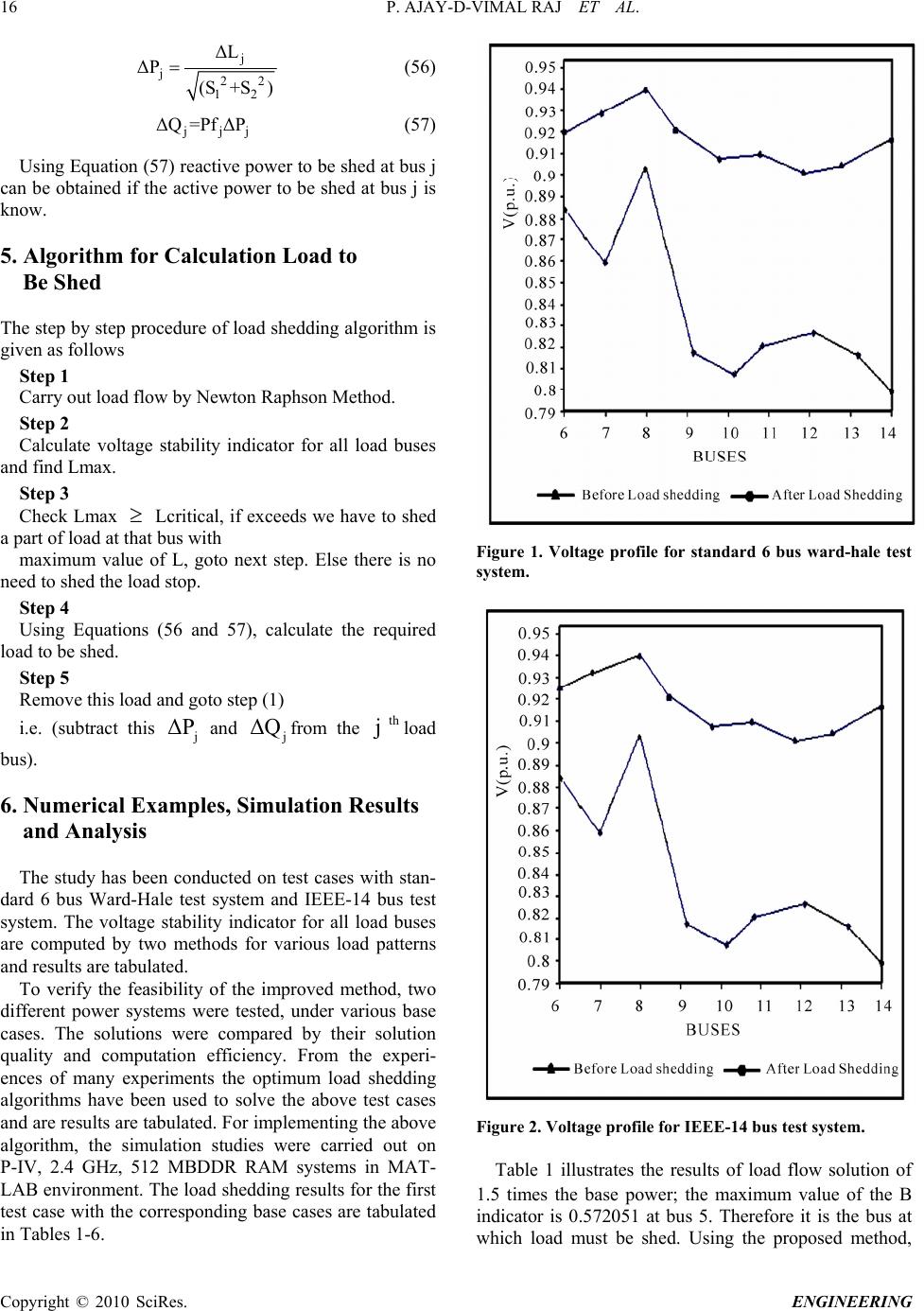 16 P. AJAY-D-VIMAL RAJ ET AL. j j22 12 ΔL ΔP (S +S) (56) jj ΔQ=PfΔPj (57) Using Equation (57) reactive power to be shed at bus j can be obtained if the active power to be shed at bus j is know. 5. Algorithm for Calculation Load to Be Shed The step by step procedure of load shedding algorithm is given as follows Step 1 Carry out load flow by Newton Raphson Method. Step 2 Calculate voltage stability indicator for all load buses and find Lmax. Step 3 Check Lmax Lcritical, if exceeds we have to shed a part of load at that bus with maximum value of L, goto next step. Else there is no need to shed the load stop. Step 4 Using Equations (56 and 57), calculate the required load to be shed. Step 5 Remove this load and goto step (1) i.e. (subtract this and from the load bus). j ΔPj ΔQth j 6. Numerical Examples, Simulation Results and Analysis The study has been conducted on test cases with stan- dard 6 bus Ward-Hale test system and IEEE-14 bus test system. The voltage stability indicator for all load buses are computed by two methods for various load patterns and results are tabulated. To verify the feasibility of the improved method, two different power systems were tested, under various base cases. The solutions were compared by their solution quality and computation efficiency. From the experi- ences of many experiments the optimum load shedding algorithms have been used to solve the above test cases and are results are tabulated. For implementing the above algorithm, the simulation studies were carried out on P-IV, 2.4 GHz, 512 MBDDR RAM systems in MAT- LAB environment. The load shedding results for the first test case with the corresponding base cases are tabulated in Tables 1-6. Figure 1. Voltage profile for standard 6 bus ward-hale test system. Figure 2. Voltage profile for IEEE-14 bus test system. Table 1 illustrates the results of load flow solution of 1.5 times the base power; the maximum value of the B indicator is 0.572051 at bus 5. Therefore it is the bus at which load must be shed. Using the proposed method, Copyright © 2010 SciRes. ENGINEERING 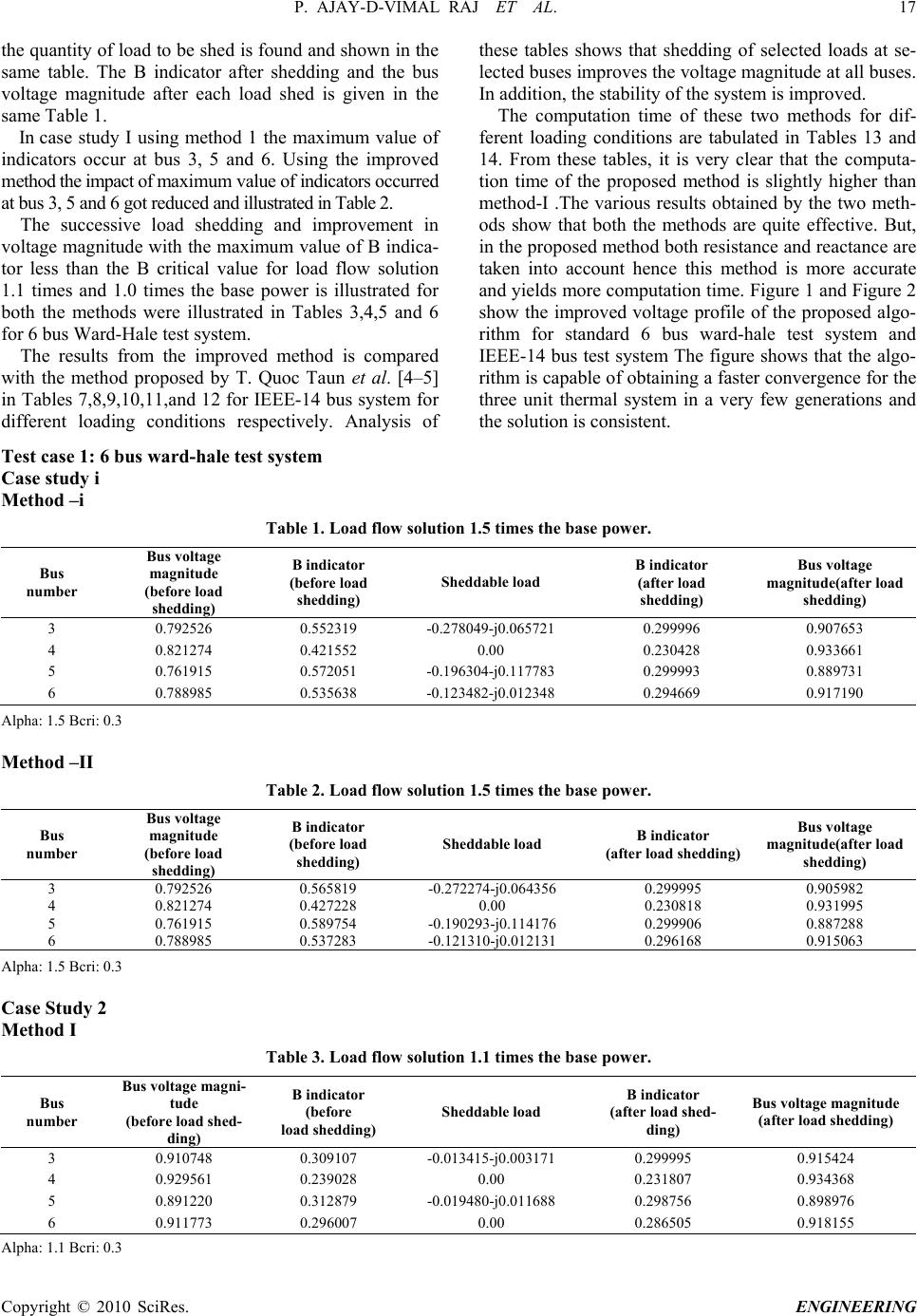 P. AJAY-D-VIMAL RAJ ET AL. 17 Copyright © 2010 SciRes. ENGINEERING the quantity of load to be shed is found and shown in the same table. The B indicator after shedding and the bus voltage magnitude after each load shed is given in the same Table 1. In case study I using method 1 the maximum value of indicators occur at bus 3, 5 and 6. Using the improved method the impact of maximum value of indicators occurred at bus 3, 5 and 6 got reduced and illustrated in Table 2. The successive load shedding and improvement in voltage magnitude with the maximum value of B indica- tor less than the B critical value for load flow solution 1.1 times and 1.0 times the base power is illustrated for both the methods were illustrated in Tables 3,4,5 and 6 for 6 bus Ward-Hale test system. The results from the improved method is compared with the method proposed by T. Quoc Taun et al. [4–5] in Tables 7,8,9,10,11,and 12 for IEEE-14 bus system for different loading conditions respectively. Analysis of these tables shows that shedding of selected loads at se- lected buses improves the voltage magnitude at all buses. In addition, the stability of the system is improved. The computation time of these two methods for dif- ferent loading conditions are tabulated in Tables 13 and 14. From these tables, it is very clear that the computa- tion time of the proposed method is slightly higher than method-I .The various results obtained by the two meth- ods show that both the methods are quite effective. But, in the proposed method both resistance and reactance are taken into account hence this method is more accurate and yields more computation time. Figure 1 and Figure 2 show the improved voltage profile of the proposed algo- rithm for standard 6 bus ward-hale test system and IEEE-14 bus test system The figure shows that the algo- rithm is capable of obtaining a faster convergence for the three unit thermal system in a very few generations and the solution is consistent. Test case 1: 6 bus ward-hale test system Case study i Method –i Table 1. Load flow solution 1.5 times the base power. Bus number Bus voltage magnitude (before load shedding) B indicator (before load shedding) Sheddable load B indicator (after load shedding) Bus voltage magnitude(after load shedding) 3 0.792526 0.552319 -0.278049-j0.065721 0.299996 0.907653 4 0.821274 0.421552 0.00 0.230428 0.933661 5 0.761915 0.572051 -0.196304-j0.117783 0.299993 0.889731 6 0.788985 0.535638 -0.123482-j0.012348 0.294669 0.917190 Alpha: 1.5 Bcri: 0.3 Method –II Table 2. Load flow solution 1.5 times the base power. Bus number Bus voltage magnitude (before load shedding) B indicator (before load shedding) Sheddable load B indicator (after load shedding) Bus voltage magnitude(after load shedding) 3 0.792526 0.565819 -0.272274-j0.064356 0.299995 0.905982 4 0.821274 0.427228 0.00 0.230818 0.931995 5 0.761915 0.589754 -0.190293-j0.114176 0.299906 0.887288 6 0.788985 0.537283 -0.121310-j0.012131 0.296168 0.915063 Alpha: 1.5 Bcri: 0.3 Case Study 2 Method I Table 3. Load flow solution 1.1 times the base power. Bus number Bus voltage magni- tude (before load shed- ding) B indicator (before load shedding) Sheddable load B indicator (after load shed- ding) Bus voltage magnitude (after load shedding) 3 0.910748 0.309107 -0.013415-j0.003171 0.299995 0.915424 4 0.929561 0.239028 0.00 0.231807 0.934368 5 0.891220 0.312879 -0.019480-j0.011688 0.298756 0.898976 6 0.911773 0.296007 0.00 0.286505 0.918155 Alpha: 1.1 Bcri: 0.3 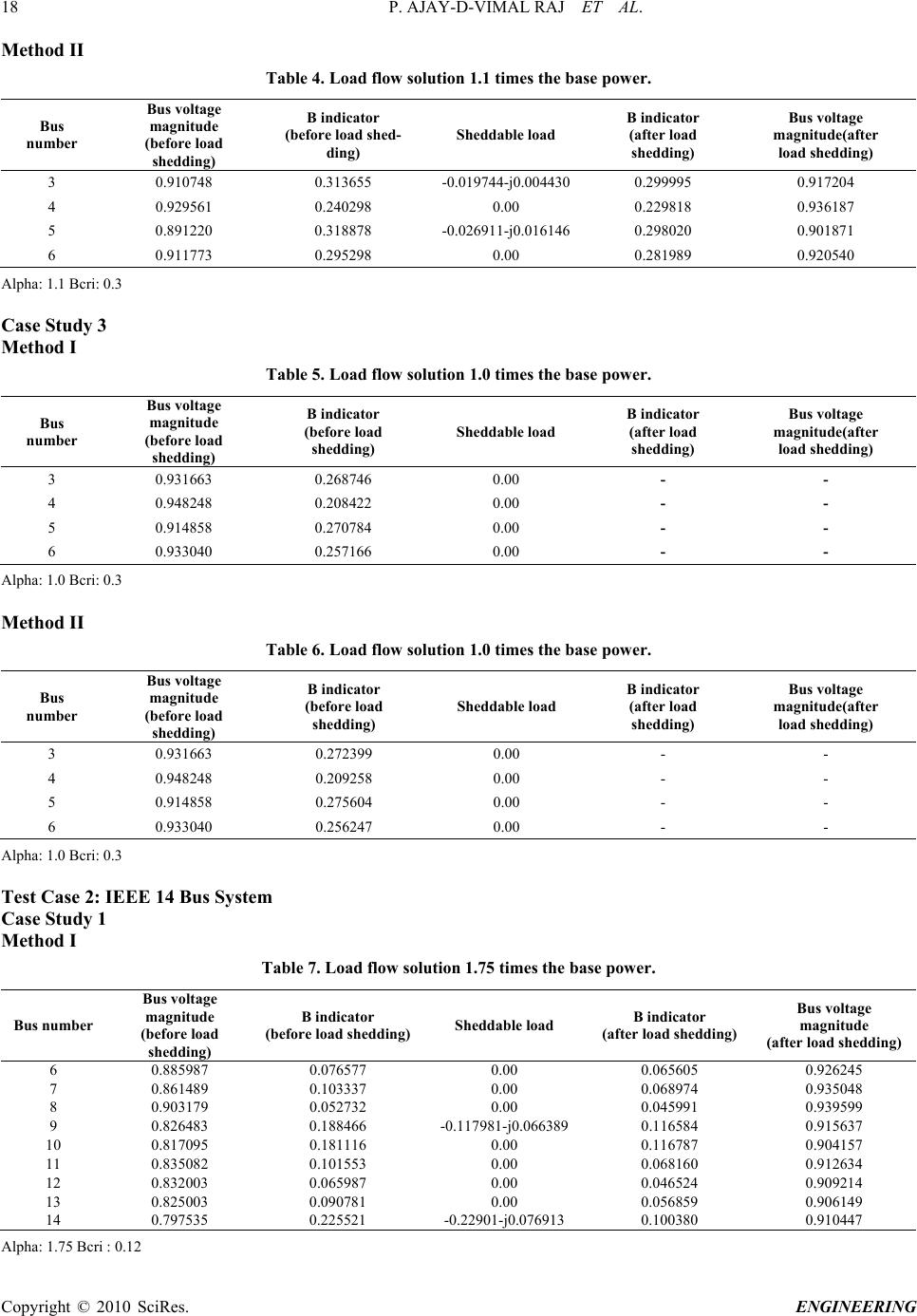 18 P. AJAY-D-VIMAL RAJ ET AL. Method II Table 4. Load flow solution 1.1 times the base power. Bus number Bus voltage magnitude (before load shedding) B indicator (before load shed- ding) Sheddable load B indicator (after load shedding) Bus voltage magnitude(after load shedding) 3 0.910748 0.313655 -0.019744-j0.004430 0.299995 0.917204 4 0.929561 0.240298 0.00 0.229818 0.936187 5 0.891220 0.318878 -0.026911-j0.016146 0.298020 0.901871 6 0.911773 0.295298 0.00 0.281989 0.920540 Alpha: 1.1 Bcri: 0.3 Case Study 3 Method I Table 5. Load flow solution 1.0 times the base power. Bus number Bus voltage magnitude (before load shedding) B indicator (before load shedding) Sheddable load B indicator (after load shedding) Bus voltage magnitude(after load shedding) 3 0.931663 0.268746 0.00 - - 4 0.948248 0.208422 0.00 - - 5 0.914858 0.270784 0.00 - - 6 0.933040 0.257166 0.00 - - Alpha: 1.0 Bcri: 0.3 Method II Table 6. Load flow solution 1.0 times the base power. Bus number Bus voltage magnitude (before load shedding) B indicator (before load shedding) Sheddable load B indicator (after load shedding) Bus voltage magnitude(after load shedding) 3 0.931663 0.272399 0.00 - - 4 0.948248 0.209258 0.00 - - 5 0.914858 0.275604 0.00 - - 6 0.933040 0.256247 0.00 - - Alpha: 1.0 Bcri: 0.3 Test Case 2: IEEE 14 Bus System Case Study 1 Method I Table 7. Load flow solution 1.75 times the base power. Bus number Bus voltage magnitude (before load shedding) B indicator (before load shedding)Sheddable load B indicator (after load shedding) Bus voltage magnitude (after load shedding) 6 0.885987 0.076577 0.00 0.065605 0.926245 7 0.861489 0.103337 0.00 0.068974 0.935048 8 0.903179 0.052732 0.00 0.045991 0.939599 9 0.826483 0.188466 -0.117981-j0.066389 0.116584 0.915637 10 0.817095 0.181116 0.00 0.116787 0.904157 11 0.835082 0.101553 0.00 0.068160 0.912634 12 0.832003 0.065987 0.00 0.046524 0.909214 13 0.825003 0.090781 0.00 0.056859 0.906149 14 0.797535 0.225521 -0.22901-j0.076913 0.100380 0.910447 Alpha: 1.75 Bcri : 0.12 Copyright © 2010 SciRes. ENGINEERING 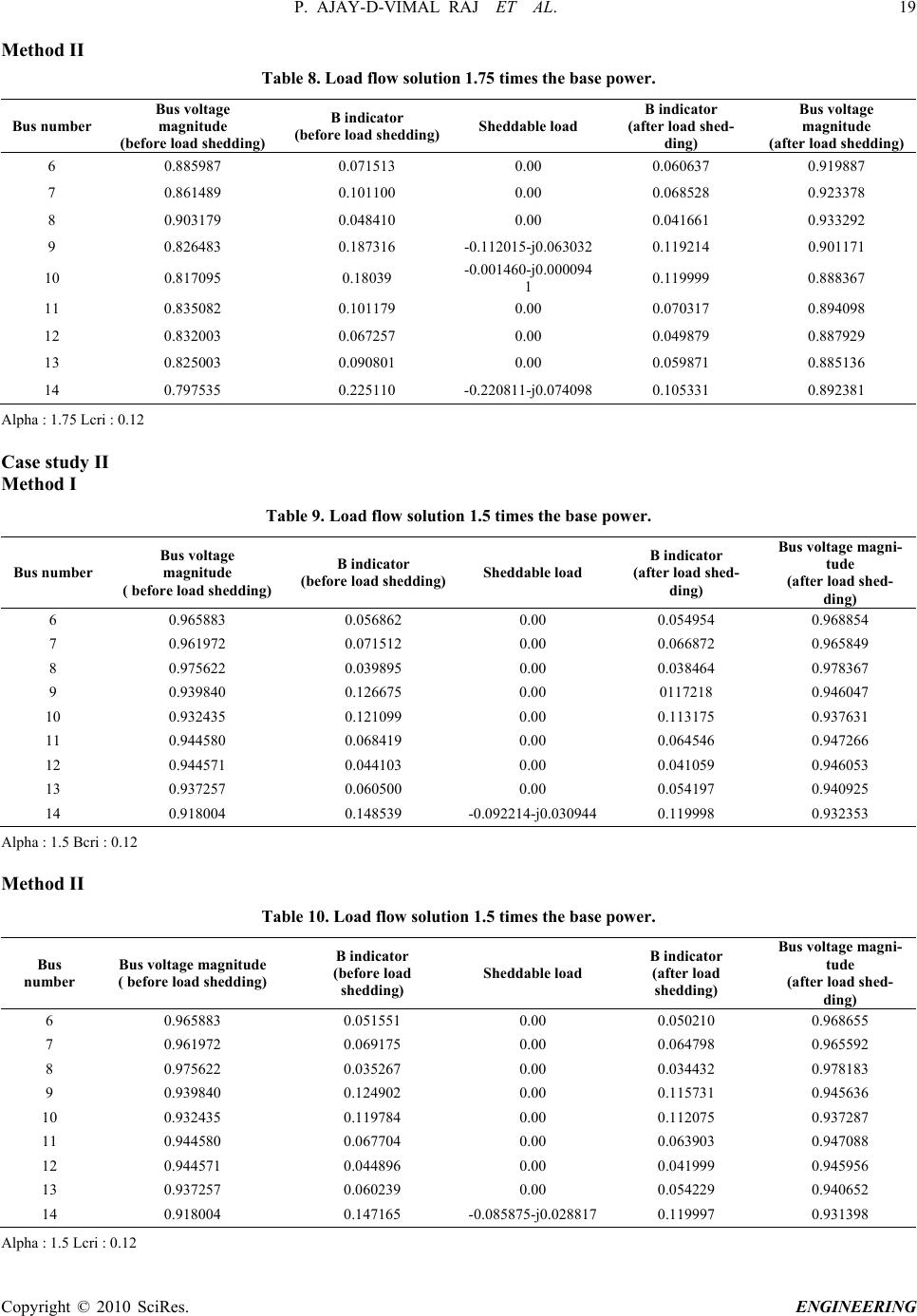 P. AJAY-D-VIMAL RAJ ET AL. 19 Method II Table 8. Load flow solution 1.75 times the base power. Bus number Bus voltage magnitude (before load shedding) B indicator (before load shedding)Sheddable load B indicator (after load shed- ding) Bus voltage magnitude (after load shedding) 6 0.885987 0.071513 0.00 0.060637 0.919887 7 0.861489 0.101100 0.00 0.068528 0.923378 8 0.903179 0.048410 0.00 0.041661 0.933292 9 0.826483 0.187316 -0.112015-j0.0630320.119214 0.901171 10 0.817095 0.18039 -0.001460-j0.000094 1 0.119999 0.888367 11 0.835082 0.101179 0.00 0.070317 0.894098 12 0.832003 0.067257 0.00 0.049879 0.887929 13 0.825003 0.090801 0.00 0.059871 0.885136 14 0.797535 0.225110 -0.220811-j0.0740980.105331 0.892381 Alpha : 1.75 Lcri : 0.12 Case study II Method I Table 9. Load flow solution 1.5 times the base power. Bus number Bus voltage magnitude ( before load shedding) B indicator (before load shedding)Sheddable load B indicator (after load shed- ding) Bus voltage magni- tude (after load shed- ding) 6 0.965883 0.056862 0.00 0.054954 0.968854 7 0.961972 0.071512 0.00 0.066872 0.965849 8 0.975622 0.039895 0.00 0.038464 0.978367 9 0.939840 0.126675 0.00 0117218 0.946047 10 0.932435 0.121099 0.00 0.113175 0.937631 11 0.944580 0.068419 0.00 0.064546 0.947266 12 0.944571 0.044103 0.00 0.041059 0.946053 13 0.937257 0.060500 0.00 0.054197 0.940925 14 0.918004 0.148539 -0.092214-j0.0309440.119998 0.932353 Alpha : 1.5 Bcri : 0.12 Method II Table 10. Load flow solution 1.5 times the base power. Bus number Bus voltage magnitude ( before load shedding) B indicator (before load shedding) Sheddable load B indicator (after load shedding) Bus voltage magni- tude (after load shed- ding) 6 0.965883 0.051551 0.00 0.050210 0.968655 7 0.961972 0.069175 0.00 0.064798 0.965592 8 0.975622 0.035267 0.00 0.034432 0.978183 9 0.939840 0.124902 0.00 0.115731 0.945636 10 0.932435 0.119784 0.00 0.112075 0.937287 11 0.944580 0.067704 0.00 0.063903 0.947088 12 0.944571 0.044896 0.00 0.041999 0.945956 13 0.937257 0.060239 0.00 0.054229 0.940652 14 0.918004 0.147165 -0.085875-j0.0288170.119997 0.931398 Alpha : 1.5 Lcri : 0.12 Copyright © 2010 SciRes. ENGINEERING 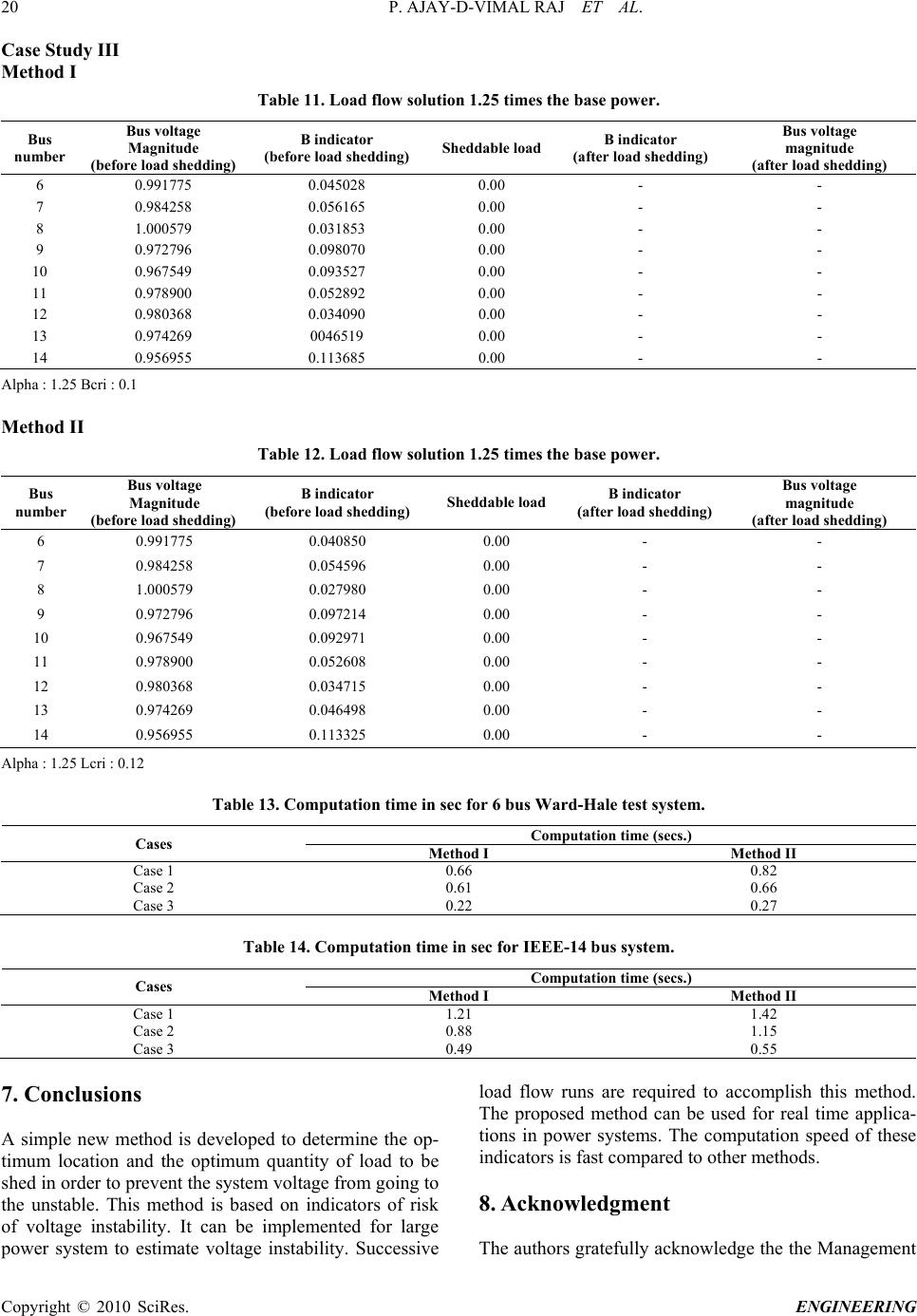 20 P. AJAY-D-VIMAL RAJ ET AL. Copyright © 2010 SciRes. ENGINEERING Case Study III Method I Table 11. Load flow solution 1.25 times the base power. Bus number Bus voltage Magnitude (before load shedding) B indicator (before load shedding) Sheddable load B indicator (after load shedding) Bus voltage magnitude (after load shedding) 6 0.991775 0.045028 0.00 - - 7 0.984258 0.056165 0.00 - - 8 1.000579 0.031853 0.00 - - 9 0.972796 0.098070 0.00 - - 10 0.967549 0.093527 0.00 - - 11 0.978900 0.052892 0.00 - - 12 0.980368 0.034090 0.00 - - 13 0.974269 0046519 0.00 - - 14 0.956955 0.113685 0.00 - - Alpha : 1.25 Bcri : 0.1 Method II Table 12. Load flow solution 1.25 times the base power. Bus number Bus voltage Magnitude (before load shedding) B indicator (before load shedding) Sheddable load B indicator (after load shedding) Bus voltage magnitude (after load shedding) 6 0.991775 0.040850 0.00 - - 7 0.984258 0.054596 0.00 - - 8 1.000579 0.027980 0.00 - - 9 0.972796 0.097214 0.00 - - 10 0.967549 0.092971 0.00 - - 11 0.978900 0.052608 0.00 - - 12 0.980368 0.034715 0.00 - - 13 0.974269 0.046498 0.00 - - 14 0.956955 0.113325 0.00 - - Alpha : 1.25 Lcri : 0.12 Table 13. Computation time in sec for 6 bus Ward-Hale test system. Computation time (secs.) Cases Method I Method II Case 1 0.66 0.82 Case 2 0.61 0.66 Case 3 0.22 0.27 Table 14. Computation time in sec for IEEE-14 bus system. Computation time (secs.) Cases Method I Method II Case 1 1.21 1.42 Case 2 0.88 1.15 Case 3 0.49 0.55 7. Conclusions A simple new method is developed to determine the op- timum location and the optimum quantity of load to be shed in order to prevent the system voltage from going to the unstable. This method is based on indicators of risk of voltage instability. It can be implemented for large power system to estimate voltage instability. Successive load flow runs are required to accomplish this method. The proposed method can be used for real time applica- tions in power systems. The computation speed of these indicators is fast compared to other methods. 8. Acknowledgment The authors gratefully acknowledge the the Management 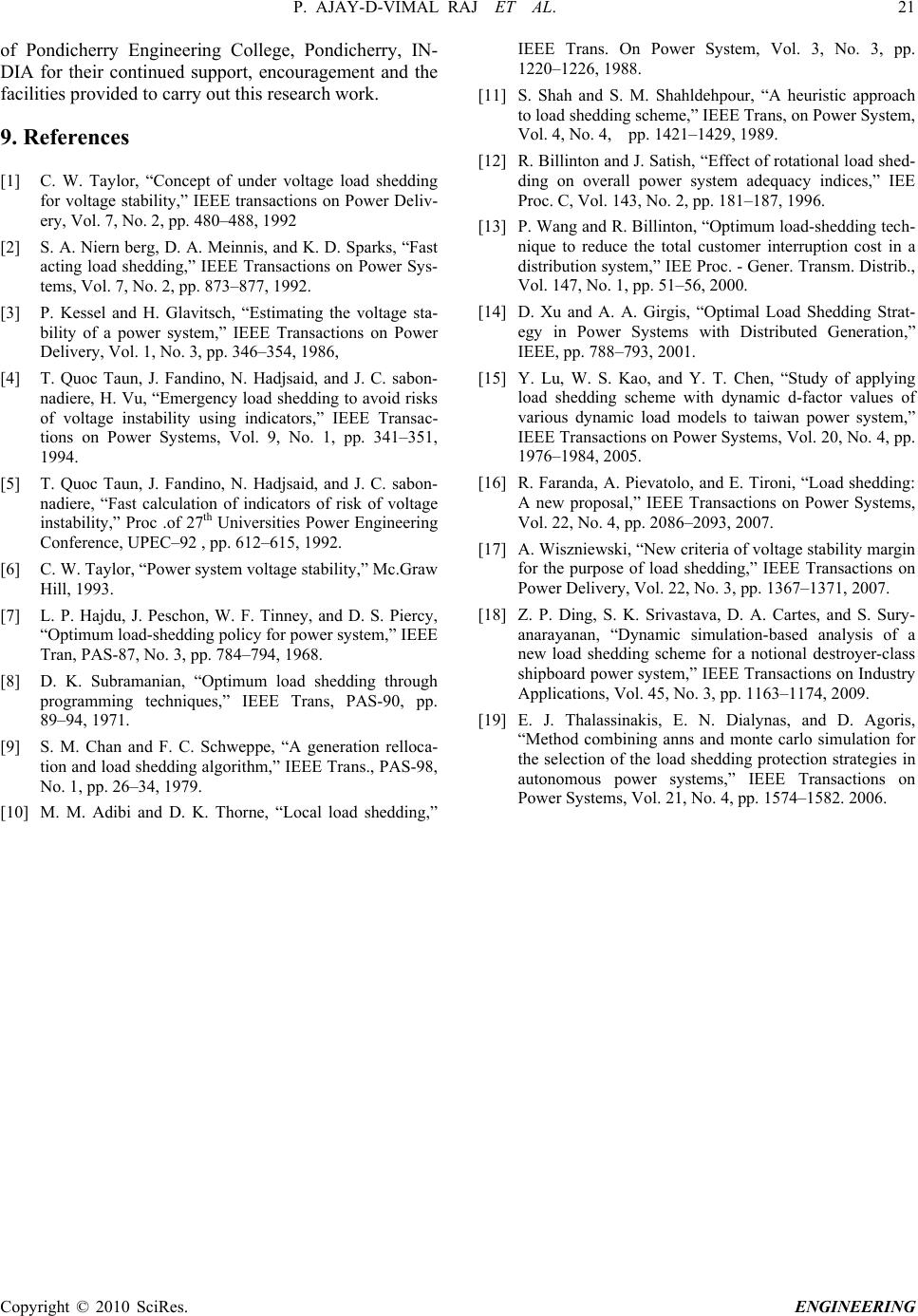 P. AJAY-D-VIMAL RAJ ET AL. 21 of Pondicherry Engineering College, Pondicherry, IN- DIA for their continued support, encouragement and the facilities provided to carry out this research work. 9 . References [1] C. W. Taylor, “Concept of under voltage load shedding for voltage stability,” IEEE transactions on Power Deliv- ery, Vol. 7, No. 2, pp. 480–488, 1992 [2] S. A. Niern berg, D. A. Meinnis, and K. D. Sparks, “Fast acting load shedding,” IEEE Transactions on Power Sys- tems, Vol. 7, No. 2, pp. 873–877, 1992. [3] P. Kessel and H. Glavitsch, “Estimating the voltage sta- bility of a power system,” IEEE Transactions on Power Delivery, Vol. 1, No. 3, pp. 346–354, 1986, [4] T. Quoc Taun, J. Fandino, N. Hadjsaid, and J. C. sabon- nadiere, H. Vu, “Emergency load shedding to avoid risks of voltage instability using indicators,” IEEE Transac- tions on Power Systems, Vol. 9, No. 1, pp. 341–351, 1994. [5] T. Quoc Taun, J. Fandino, N. Hadjsaid, and J. C. sabon- nadiere, “Fast calculation of indicators of risk of voltage instability,” Proc .of 27th Universities Power Engineering Conference, UPEC–92 , pp. 612–615, 1992. [6] C. W. Taylor, “Power system voltage stability,” Mc.Graw Hill, 1993. [7] L. P. Hajdu, J. Peschon, W. F. Tinney, and D. S. Piercy, “Optimum load-shedding policy for power system,” IEEE Tran, PAS-87, No. 3, pp. 784–794, 1968. [8] D. K. Subramanian, “Optimum load shedding through programming techniques,” IEEE Trans, PAS-90, pp. 89–94, 1971. [9] S. M. Chan and F. C. Schweppe, “A generation relloca- tion and load shedding algorithm,” IEEE Trans., PAS-98, No. 1, pp. 26–34, 1979. [10] M. M. Adibi and D. K. Thorne, “Local load shedding,” IEEE Trans. On Power System, Vol. 3, No. 3, pp. 1220–1226, 1988. [11] S. Shah and S. M. Shahldehpour, “A heuristic approach to load shedding scheme,” IEEE Trans, on Power System, Vol. 4, No. 4, pp. 1421–1429, 1989. [12] R. Billinton and J. Satish, “Effect of rotational load shed- ding on overall power system adequacy indices,” IEE Proc. C, Vol. 143, No. 2, pp. 181–187, 1996. [13] P. Wang and R. Billinton, “Optimum load-shedding tech- nique to reduce the total customer interruption cost in a distribution system,” IEE Proc. - Gener. Transm. Distrib., Vol. 147, No. 1, pp. 51–56, 2000. [14] D. Xu and A. A. Girgis, “Optimal Load Shedding Strat- egy in Power Systems with Distributed Generation,” IEEE, pp. 788–793, 2001. [15] Y. Lu, W. S. Kao, and Y. T. Chen, “Study of applying load shedding scheme with dynamic d-factor values of various dynamic load models to taiwan power system,” IEEE Transactions on Power Systems, Vol. 20, No. 4, pp. 1976–1984, 2005. [16] R. Faranda, A. Pievatolo, and E. Tironi, “Load shedding: A new proposal,” IEEE Transactions on Power Systems, Vol. 22, No. 4, pp. 2086–2093, 2007. [17] A. Wiszniewski, “New criteria of voltage stability margin for the purpose of load shedding,” IEEE Transactions on Power Delivery, Vol. 22, No. 3, pp. 1367–1371, 2007. [18] Z. P. Ding, S. K. Srivastava, D. A. Cartes, and S. Sury- anarayanan, “Dynamic simulation-based analysis of a new load shedding scheme for a notional destroyer-class shipboard power system,” IEEE Transactions on Industry Applications, Vol. 45, No. 3, pp. 1163–1174, 2009. [19] E. J. Thalassinakis, E. N. Dialynas, and D. Agoris, “Method combining anns and monte carlo simulation for the selection of the load shedding protection strategies in autonomous power systems,” IEEE Transactions on Power Systems, Vol. 21, No. 4, pp. 1574–1582. 2006. Copyright © 2010 SciRes. ENGINEERING |

